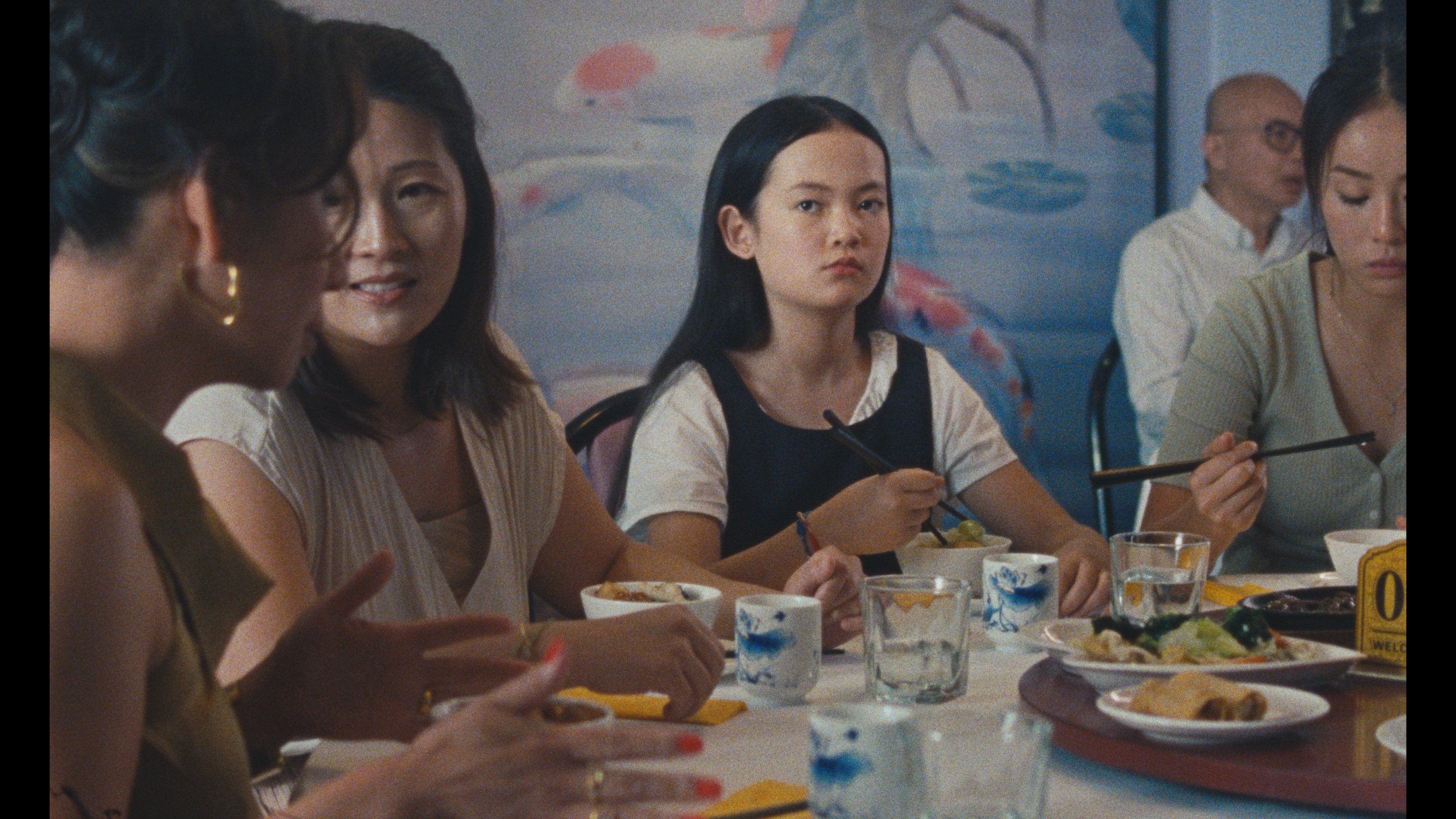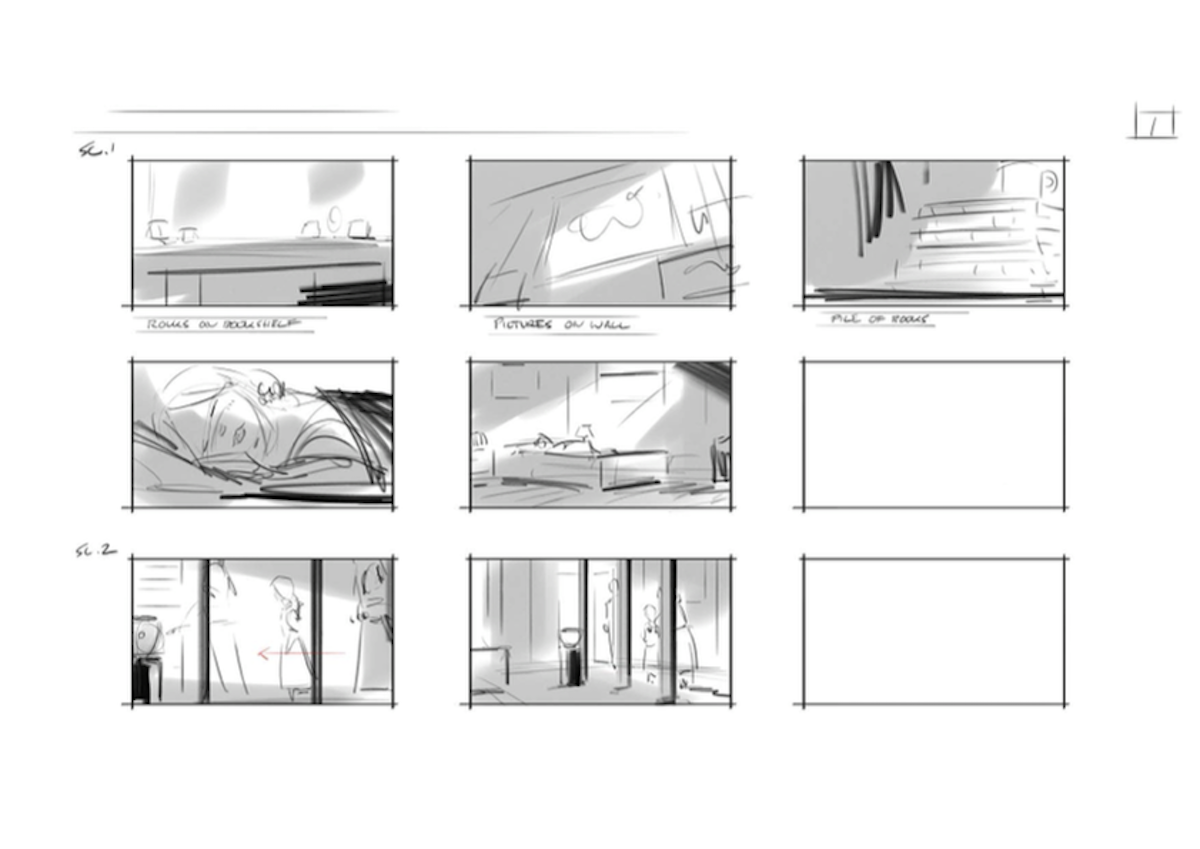
When The Sky Was Blue: Behind the scenes
I began writing this film during an incredibly transformative and transitional time, during which buried childhood memories would emerge and wade into my periphery, demanding that I pay attention. I was faced with confronting reminders of loneliness and self-doubt, and the sweeping ambivalence that comes with straddling multiple worlds and being too young to understand how or why.
Step-by-step production process
Learn more about the way professional media makers create work. The Media Production Process includes development, pre-production, production, post-production and distribution.
This resource draws on production and distribution materials for the celebrated short film When the Sky was Blue to introduce the creative industry practices that relate to each stage of the production process.
In this resource you will find:
- behind-the-scenes information shared by filmmaker Rae Choi
- reflective questions relating to filmmaking practices
- links to ACMI creative resources
Recommended for Year levels: 7–12
Learning areas: Media
One Sunday between meals and chores with her family, ten-year-old Leah experiences small but striking moments of longing and loss. A series of reimagined memories, the film offers a meditative and wistful glance into the intersectional identities of being Chinese-Australian.
Watch
You can also access When the Sky was Blue on SBS on demand: https://www.sbs.com.au/ondemand/movie/when-the-sky-was-blue/2286890563660
Development
The idea
Creating an effective short film like When the Sky was Blue requires a lot of planning and preparation.
When planning a script, the writer starts with a theme or an idea. You can separate the theme from the plot by saying the plot is what happens in the film, and the theme is what the film is about. The theme might change or grow as the story develops, but it provides a great starting point.
Ideas for film narratives are often inspired by a memorable experience, familiar place or everyday event. From this starting point, the screenwriter continues to craft the story using their imagination and unique way of looking at the world.
In writing and directing When the Sky was Blue , Rae Choi drew on memories of her childhood and her Chinese-Australian cultural identity.
You can read more about what inspired her to tell this story in this interview.
Logline
In developing a story idea, it can be helpful to write a logline, a very simple one or two sentence summary of the story you plan to tell. Here is the logline used in the project development stage for When the Sky was Blue:
One Sunday after church, eleven-year-old Leah experiences a series of small but striking coming-of-age and intercultural moments as she wrestles with her conflicted relationship with her immigrant mother.
The synopsis
Next comes your synopsis, which reads more like a short story, and tells the reader what is going to happen in the film – its plot. You can download the synopsis of When the Sky was Blue. This is a great example of this step in the screenwriting process.
When the Sky was Blue synopsis
When the Sky was Blue screenplay
Choi has shared the script for the film. You can download it below.
Reflect and respond
- By the time, When the Sky was Blue was released, the team had changed the logline to reflect the completed film: One Sunday between meals and chores with her family, ten-year-old Leah experiences small but striking moments of longing and loss. Compare the two versions. What has changed?
- When you get to the section looking at the Distribution stage, you will also see the synopsis is a little different from the one written as part of the Development process. Compare the two and note down what is different.
- Read the first page of the script. What do you notice about the layout and formatting? Why do you think the screenplay is formatted like this?
- This script includes much more than dialogue. What kind of extra information is included?
- This first page includes two brief opening scenes and the opening section of scene 3. What do we learn about the setting for these scenes? Which words and details stand out for you?
- As well as building a rich sense of the world, the scene descriptions also start building character and story. Which details do this and how?
- Find out more about screenwriting – Are you inspired to create your own short film and want to get started on the screenplay? ACMI's Film It: the Filmmakers toolkit includes a screenwriting module that covers formatting, scene writing, script structure, themes, and character.
Funding
Alongside the creative energy put into the development of When the Sky was Blue, Choi and her fellow producer Sheree Ramage had the huge task of procuring funding for this project. One source of funding is grants from national and state screen bodies. Applying for these grants is a skill in itself.
When the Sky was Blue was selected for Screen Queensland's RIDE Shorts initiative developed to support and early career filmmakers from underrepresented backgrounds. As well as receiving funds, this initiative offered support through the key stages of the production process as well as the incredible opportunity to premiere the film at the Brisbane International Film Festival in 2021.
You can see the project overview the team prepared to procure further funding and distribution below.
Reflect and respond
- Why do you think it is important for bodies such as Screen Queensland to support filmmakers from underrepresented backgrounds?
When the Sky was Blue project overview
Pre-production
Once the script is in place and the budget and funding are sorted, it is time for the pre-production phase.
During this stage, the planning carried out in the development stage helps the filmmaker as they work with people in their specialist roles o plan and organise the film, making important decisions about how the film is going to look and sound. It is at this stage that the storyboards are drawn and choices are made about production and costume design.
Storyboarding
In a film, the audience follows a story not just through the characters' dialogue, but also through their actions. Even objects and settings help tell a story. A storyboard is a shot-by-shot visual plan that shows what a film will look like before the film is shot. It acts as a visual guide to the team shooting the film.
Refer to the section of the storyboard created for the opening of When the Sky was Blue (below).
If you want to look a bit more closely, you can download the entire film storyboard created by storyboard artist Sam Uther.
Storyboard: Scene 1 When the Sky was Blue

When the Sky was Blue storyboard
Reflect and respond
- Label the shot types planned in the storyboard frames.
- Compare the storyboard frames with the opening scene of Choi's film. Which shots reflect the original plan? What changes have been made during the shoot and/or the editing process? Why do you think these new choices were made? Explain.
- Find out more about storyboarding – When you are planning your own film shoot creating a storyboard is essential. Not only will it help you organise your ideas and keep the shoot on track, it is also an important reference point for the multiple team members contributing to the film. Dig deep into the Script to Storyboard process with this ACMI resource.
Production design
It is the production designer's role to create the world of the film. The production designer uses their expertise to realise the director's creative vision about how the world of the film should look. For instance, in the script of When the Sky was Blue, the front door area of Leah's home is described as "modern, clean-cut and self-conscious". This is an evocative description that the production designer, Arundhati Madan, would have teased out through conversation with Choi. After making decisions about the overall look of the film supported by the mood board created during the development process, Madan located and designed the spaces featured in the film, and led the art design team as they brought the world of the narrative to life.
Costume design
It is the costume designer's role to use costume to build character and help tell the story. They therefore need to have a deep understanding of: the story that the director wants to tell, how each character fits into this framework, and how they will develop and evolve.
Production designer Arundhati Madan also took on the role of costume designer for When the Sky was Blue. Because the production designer and costume designer always work closely together to create the look of a film, it would have been efficient and effective for Madan to oversee both costume and production design on this relatively small project. However, there are examples of these roles being combined in large-scale productions. Most famously, Australian designer Catherine Martin has been celebrated for her role as production and costume designer for Baz Luhrmann's feature films.
Reflect and respond
- Imagine you are the production designer (whose job is to work with the set designer to create the world of the film). How would you create a room that is described as "modern, clean-cut and self-conscious"?
- A motif is a recurring theme. One of the motifs in When the Sky was Blue is fish. How have fish been incorporated into the production design? (Remember everything you see in the world of the film is the result of a decision made by the production designer.)
- List 3 or 4 words that describe the mood and feeling of When the Sky was Blue. How has the production design contributed to this mood?
- Take note of the costumes chosen for the actors to wear. What do they communicate about the characters and about the story?
Production
The production stage, when filming takes place, is also known as 'principal photography'.
Cinematography
With adequate planning during pre-production, shooting the film should progress smoothly.
Bonita Carzino was the director of photography for When the Sky was Blue, and it was her role to work with Choi to consider the framing and lighting of each shot.
The film was shot on 16mm film, which gives it the gentle grainy quality that adds to the mood and feel of the narrative. It also meant that Choi and her team had to plan and shoot very carefully and thoughtfully as the team would need to wait for the film to be developed to know what they captured during the shoot.
Reflect and respond
- Choose a scene from the film and note down the camera angles and framing used. How do these choices convey meaning? Why have they been chosen?
- How does the camera connect the viewer to Leah's point of view?
- Think about Choi's decision to use 16mm film rather than a digital camera. How does the texture and grain of the film change the mood? What does it add? You can find out a bit more about the rewards and challenges of this analogue process here.
- What type of lighting is used? What is the effect?
- Find out more about cinematography – ACMI's Film It: the Filmmakers toolkit includes a cinematography module that will give you great insights into camera shots, angles, and movement.
Sustainability
Filmmaking has a significant environmental impact. Choi's team worked hard to introduce sustainable practices during the shoot wherever possible. One focus was on catering, as this can be very wasteful.
Reflect and respond
- To find out about how filmmaking can be more sustainable, visit Sustainable Screens Australia. Many of the practices and suggestions relate to large-scale film productions, but other recommendations include changes that apply to even the smallest production such as swapping out single-use items for reusable ones.
- See below part of a longer Instagram post about sustainable practices on the set of When the Sky was Blue. What is the purpose and impact of sharing this kind of information on social media during a shoot?

Post-production
During the Post-production Stage, production components are put together to make a completed film project. Sound, titles and effects are also added.
Editing
During the editing process, the film editor puts the shots together using the script and the storyboard as a guide. In collaboration with the director, the editor makes decisions and choices about which shots to use and how to pace the narrative.
When the Sky was Blue was edited by Navaz Illava, who has played a pivotal role in drawing viewers into Leah's point of view and connecting them with her emotional journey.
Reflect and respond
- Cinematography and editing are interconnected. Have another look at the scene where you analysed the shot choices and describe how the shots have been edited together. Think about the order of the shots, the transitions and the pacing.
- Describe how the editing of the shots in this scene connect viewers to Leah's point of view and help communicate her thoughts and feelings.
- Find out more about editing – ACMI's Film It: the Filmmakers toolkit includes an editing module that gives you the chance to try editing with supplied footage.
Sound and music
The music in When the Sky was Blue was composed by Brodie McAllister. It is a powerful part of the storytelling, as is the soundscape. Choi worked with the sound designer Dylan Barfield to mix diegetic and non-diegetic sound and music to tell the story. (Diegetic sound is part of the world of the film and non-diegetic sound can only be heard by viewers.)
The non-diegetic soundscape makes a powerful impact on the storytelling in the scene at the restaurant when the mothers are gossiping. Here, the contrast between the outward ordinariness of the setting and Leah's internal discomfort is expressed through sound, as the diegetic bustle of the restaurant gives way to the rumbling, dissonant non-diegetic soundscape.
Reflect and respond
- Return to the scene you focused on for your visual analysis and consider the way sound impacts the narrative and connects or contrasts with the visuals. What types of sounds can you identify within the scene? How do these sounds complement the imagery and contribute to character development? How do these sounds indicate mood, time or action? Pinpoint diegetic and non-diegetic sounds.
- It is easy to underestimate the importance of sound in filmmaking until you watch a film with bad sound quality and realise how much that interferes with your enjoyment. Find out more about sound recording – ACMI's Film It: the Filmmakers toolkit includes an sound recording module that gives you step-by-step advice for planning your own film.
Distribution
Due to the funding When the Sky was Blue received from Screen Queensland, the film premiered at the prestigious Brisbane Film Festival in 2021 and has since had multiple festival screenings, including on ACMI's Cinema 3 as part of the Other Film Festival. The film was also a finalist in the Screen Producers Australia Awards (2023) for Best Short Film Production and has been nominated for an Australian Writers Guild Award.
Festival screenings are an important way for short films to find an audience and the prestige they provide can help finance future projects.
Rae Choi has provided the press kit created to market When the Sky was Blue, as well as to highlight the contribution of the filmmaking team. (See below.) A press kit is a publication that provides information about your film for the purpose of representing and marketing your film to festivals, the media and other interested parties.
Reflect and respond
- What stands out for you in the When the Sky was Blue press kit? How effectively do you think it represents the film? Is there other information you would have liked to find out about?
- There is some great advice online about the correct format for a press kit. When you have completed your production, why not add some extra impact by putting together a press kit following these guidelines.
When the Sky was Blue presskit
Other short film resources
You now know plenty about ACMI's Film It resource, and we hope you find it helpful when you are making your own short films.
Other helpful resources include:
The short film formula compiled by expert media teacher Brett Lamb
How to make an amazing short film: top hacks from a festival director written by Jackson Lapsley Scott director of The Heart of Gold Short Film Festival in Gympie.
Ten tips for student filmmakers making their first short films from Richard Rankin of the Raindance Film Festival
There is a wealth of advice and behind the scenes information on the No Film School website.
You can also download the student filmmaking resource from AFTRS (Australian Film, Television and Radio School).
THANK YOU
We are grateful to filmmaker Rae Choi for her generosity in sharing filmmaking resources and documents that offer valuable insights into the production process of When the Sky was Blue.